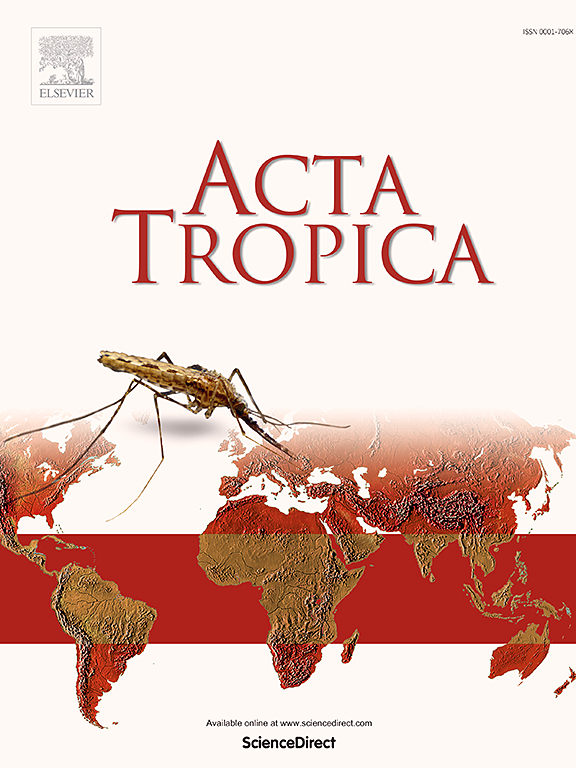How do I look when I'm infected? Morphometric changes in heads associated with Trypanosoma cruzi infection in flightless Triatominae
IF 2.1
3区 医学
Q2 PARASITOLOGY
引用次数: 0
Abstract
Mepraia spinolai is a triatomine endemic to Chile vector of Trypanosoma cruzi (the causative agent of Chagas disease) that presents a marked wing polymorphism. This study investigates morphometric changes in the heads of flightless individuals of this vector. It is known that infection by T. cruzi produces physiological, morphological, and behavioral changes, among others, in triatomine vectors. This study aims to evaluate whether T. cruzi infection modifies head morphometry in micropterous M. spinolai, and to infer the behavioral and ecological implications of such changes. Results revealed that infected individuals had significantly smaller heads in both sexes. Shape analysis distinguished infected from uninfected groups, showing infected individuals with wider heads and smaller eyes in both sexes. Furthermore, in infected females, the heads were shorter. Fluctuating asymmetry of shape (FA), was higher in infected insects, suggesting T. cruzi imposes physiological costs. Reduced eye size and head width could impair vision-based behaviors like host-seeking or predator avoidance, while increased FA indicates infection-related stress. These findings highlight the phenotypic plasticity of triatomines under parasitic infection and suggest potential biomarkers for identifying infected vectors. This is the first experimental study to characterize morphological changes in the heads of triatomines infected with T. cruzi, and also the first to analyze them in micropteran insects. Identifying morphometric traits in heads associated with infection could optimize entomological surveillance strategies in endemic areas, particularly for M. spinolai where the use of wing morphology as a diagnostic tool is restricted, and for nymphal instars of other triatomine species.
我被感染时是什么样子?不会飞的三角蝇感染克氏锥虫后头部形态学改变。
棘锥虫是智利特有的克氏锥虫(恰加斯病的病原体)病媒,具有明显的翅膀多态性。本研究调查了该媒介的不会飞行个体头部的形态变化。已知克氏锥虫感染会在锥蝽病媒中产生生理、形态和行为变化等。本研究旨在评估克氏锥虫感染是否会改变棘足小翼鼠的头部形态,并推断这种变化的行为和生态意义。结果显示,受感染的个体在两性中头部明显较小。形状分析将感染者与未感染者区分开来,结果显示,无论男女,感染者的头都更宽,眼睛更小。此外,在受感染的雌性中,头部更短。受感染昆虫的形状波动不对称(FA)更高,表明克氏锥虫施加了生理代价。眼睛大小和头宽的减小可能会损害以视觉为基础的行为,如寻找宿主或躲避捕食者,而FA的增加表明感染相关的压力。这些发现突出了寄生虫感染下三粒蝽的表型可塑性,并为鉴定感染载体提供了潜在的生物标志物。这是首次对感染克氏锥虫的锥蝽头部形态变化进行表征的实验研究,也是首次在微翼目昆虫中对其进行分析。鉴定与感染相关的头部形态特征,可以优化流行地区的昆虫学监测策略,特别是对刺叶螨和其他三角蝽属昆虫的若虫,在这些地区,翅膀形态作为诊断工具的使用受到限制。
本文章由计算机程序翻译,如有差异,请以英文原文为准。
求助全文
约1分钟内获得全文
求助全文
来源期刊

Acta tropica
医学-寄生虫学
CiteScore
5.40
自引率
11.10%
发文量
383
审稿时长
37 days
期刊介绍:
Acta Tropica, is an international journal on infectious diseases that covers public health sciences and biomedical research with particular emphasis on topics relevant to human and animal health in the tropics and the subtropics.
 求助内容:
求助内容: 应助结果提醒方式:
应助结果提醒方式:


